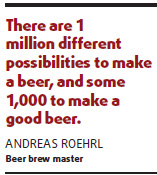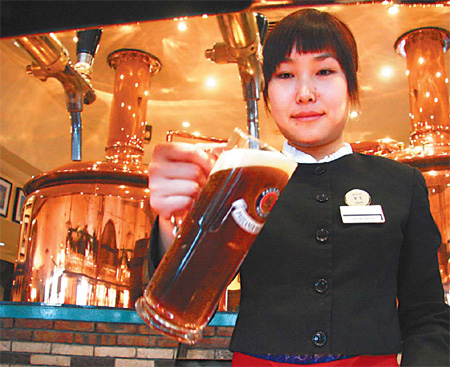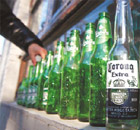Expats
Brewers quench thirst for real ale
By Christine Laskowski (China Daily)
Updated: 2010-01-08 09:13
 |
Large Medium Small |
|
|
China has still got a long way to go when it comes to beer. Local beer is cheap, but you get what you pay for; imported beers offer respite from watery brews, but for a price.
But there are, thankfully, a few restaurants right here in Beijing where delicious ales and lagers are brewed in-house for decent prices. And such a complex, refined process yields some pretty unbelievable beer.
With Germany's reputation as having beer-making and its consumption as a national pastime, it should come as no surprise to learn that two of Beijing's microbreweries are restaurant franchises from the southern Bavaria region, where brewing beer is an art form.
"My father had a brewery, my father's father had a brewery it was always my dream to run a small brewhouse and control the process from beginning to end," said Bavarian Andreas Roehrl, the brew master at Drei Kronen 1308.
"I have recipes that I have to brew," he said, referring to beers that corporate headquarters requires him to make.
"But the Wheatbeer Bock, I have a special recipe."
Coming from a long line of brewers, Roehrl uses an old family recipe.
He explains that his Wheatbeer Bock (Bock being a type of strong lager beer) is 7 percent alcohol with 17 percent sugar gravity (which refers to the percentage of sugar before fermentation).
"So be careful," he warned, grinning.
Stefan Frank, brew master at Paulaner Brauhaus, another Bavarian restaurant and microbrewery, also brews his beer with great pride.
"It's all made from raw materials," Frank said, pointing to the three types of barley malt on display: Munchner, Pilsen, and Gerostetes to make the Schrot, which is a refined mix of different combinations of the malts to make the beer.
For wheat beer, they use wheat malt. All are imported from Germany.
Both Drei Kronen and Paulaner Brauhaus's brew masters abide by The Purity Law of 1516, which states that only water, malt, hops and yeast can be used to make beer.
"Nothing else," said Frank resolutely. "No chemicals."
According to both Roehrl and Frank, The Purity Law of 1516 is the oldest food law in the world.
In answer to the question of how so many flavors and colors can come from four basic ingredients, Roehrl responded: "You have many possibilities in the malt, and the raw barley in the maltery when they dry.
"With the barley, you play with the colors and temperatures. And hops, there are so many different kinds," he explained. "There are 1 million different possibilities to make a beer, and some 1,000 to make a good beer."
Frank, who has been brewing beer in China for 17 years, has witnessed first-hand the growing popularity of micro-brewed beer in the country.
With eight Paulaner Brauhauses in China, Frank says the outlets are certainly not appealing only to foreigners.
"Well, every year we seem to open a new brewhouse in China," said Frank.
"If you have a look outside and see how many BMWs and Ferraris there are, you see that the people who can afford it want quality."
The restaurants have enormous copper kettles on display behind their bars, but both Roehrl and Frank readily admit they are for show - the real brewing takes place mainly in fermentation and maturation tanks away from the customers' view.
Fermentation occurs after yeast is added to the malt, hops and water mash.
After a series of processes, including aeration and temperature changes, the malt sugar changes into alcohol and carbon dioxide, which gives beer its bubbles.
At Paulaner, one fermentation tank contains 2,000 liters.

The entire fermentation process takes place over six or seven days before the mixture is pumped to maturation tanks and stored for three to four weeks.
"The rule is that the stronger the beer, the longer the storage," Frank explained.
"For instance, the Salvator needs storage for eight to 10 weeks ... It needs more time to lower the gravity and more storage time to get the clean beer."
When the beer is ready for drinking, it is pumped to dispensing tanks and then to the bar.
Because beer should not come into contact with oxygen, both Roehrl and Frank use a system in which a mixture of CO2 and nitrogen push the liquid to the tap.
The strict attention to detail and fresh, imported ingredients help with the taste, as does brewing smaller quantities, he said.
But more than anything, it is the less rushed brewing process that separates microbreweries from the large operations.
"That's the difference between us and industrial brewers," Roehrl explained. "We take our time."









